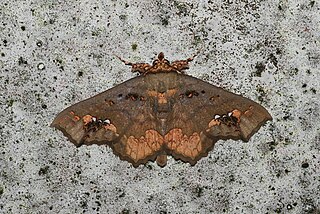
Urodidae or "false burnet moths" is a family of moths in the lepidopteran order. It is the type genus in the superfamily, Urodoidea, with three genera, one of which, Wockia, occurs in Europe.

Heliodinidae, commonly known as sun moths, is a family of small moths with slender bodies and narrow wings. Members of this family are found in most parts of the world. Heliodinid moths are brightly coloured day-flying moths. The base of the haustellum is bare. The scales on the head are compact and appear like a shield. Many Heliodinidae raise their hindlegs when resting but this is not a taxonomic feature and several genera like Epicroesa and Lamprolophus do not show this posture. Many Heliodinidae have the inner and outer spurs of the metatibia subequal. The larval host plants of the majority of species are in the Aizoaceae, Chenopodiaceae, Phytolaccaceae, Portulacaceae and Nyctaginaceae, all in the Order Caryophyllales. A few feed on Onagraceae, Araliaceae and Piperaceae. The pupae have long stiff hairs on their back sides.
Metachanda is the sole genus in tribe Metachandini of moth subfamily Oecophorinae. Metachandini was originally described as family Metachandidae by Edward Meyrick in 1911, and at the time also contained the genus Chanystis, which is currently unplaced to tribe within Oecophorinae. It has also previously been described as tribe Metachandini of subfamily Gelechiinae.
Agathiphaga is a genus of moths, known as kauri moths. It is the only living in the family Agathiphagidae. This caddisfly-like lineage of primitive moths was first reported by Lionel Jack Dumbleton in 1952, as a new genus of Micropterigidae.
Atypha is a monotypic moth genus of the family Noctuidae erected by Jacob Hübner in 1821. Its only species, Atypha pulmonaris, was first described by Eugenius Johann Christoph Esper in 1790. It is found in southern and central Europe, northern Turkey, Transcaucasia and the Caucasus.

Egybolis is a monotypic moth genus of the family Noctuidae erected by Jean Baptiste Boisduval in 1847. Its only species, Egybolis vaillantina, the African peach moth, was first described by Caspar Stoll in 1790. It is found in the Afrotropical realm.

Lopharthrum is a monotypic moth genus of the family Erebidae erected by George Hampson in 1895. Its only species, Lopharthrum comprimens, was first described by Francis Walker in 1858. It is found from the Indian subregion to New Guinea and the Solomons.
Anthalma is a monotypic moth genus in the family Geometridae. Its only species, Anthalma latifasciata, is found in Panama. Both the genus and species were first described by Warren in 1901.

Blepharoctenucha is a monotypic moth genus in the family Geometridae described by Warren in 1895. Its only species, Blepharoctenucha virescens, first described by Arthur Gardiner Butler in 1880, is known from India and Taiwan.
Buttia is a monotypic moth genus in the family Geometridae described by Warren in 1904. Its only species, Buttia noctuodes, was described by the same author in the same year.
Caledasthena is a monotypic moth genus in the family Geometridae. Its single species, Caledasthena montana, is found in New Caledonia in the south-west Pacific Ocean. Both the genus and species were first described by Jeremy Daniel Holloway in 1979.
Celonoptera is a monotypic moth genus in the family Geometridae. Its only species, Celonoptera mirificaria, is found in south-eastern Europe. Both the genus and species were first described by Julius Lederer in 1862.

Declana is a genus of moths in the family Geometridae that is endemic to New Zealand. The genus was erected by Francis Walker in 1858.
Entogonia is a genus of moths in the family Geometridae described by Warren in 1904.
Ischnopteris is a genus of moths in the family Geometridae described by Jacob Hübner in 1823.
Ithysia is a monotypic moth genus in the family Geometridae. Its only species is Ithysia pravata. The genus was erected by Jacob Hübner in 1825, but the species had been first described by Hübner in 1813.

Lipomelia is a monotypic moth genus in the family Geometridae. It contains only one species, Lipomelia subusta, which is found in India and Taiwan. Both the genus and species were first described by William Warren in 1893.
Megalotica is a genus of moths in the family Geometridae described by Zimmerman in 1958.
Panagropsis is a monotypic moth genus in the family Geometridae described by Warren in 1894. Its only species, Panagropsis equitaria, described by Francis Walker in 1861, is found in South Africa.
Syzeuxis is a genus of moths in the family Geometridae erected by George Hampson in 1895.







